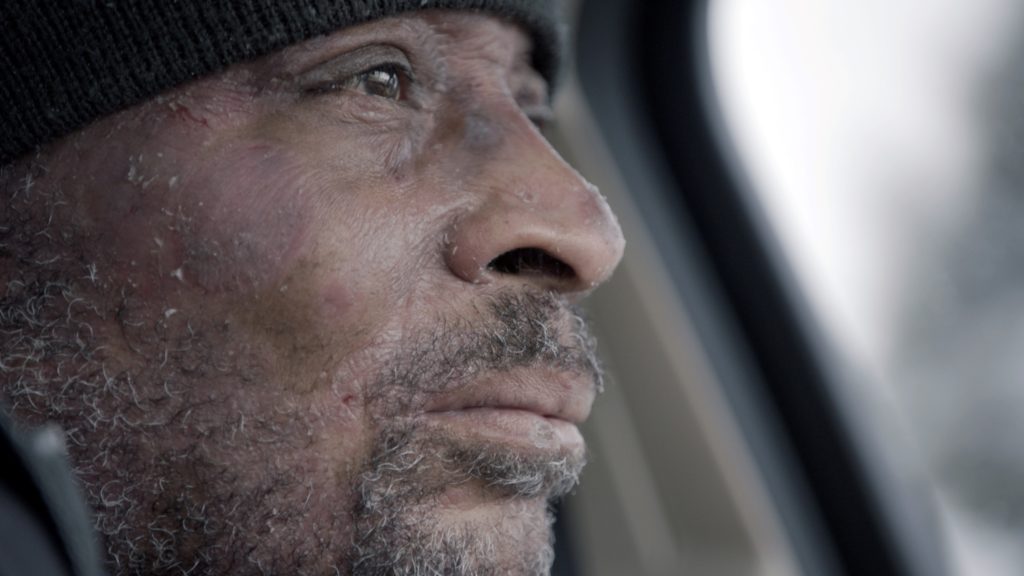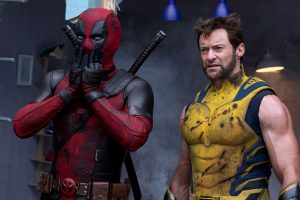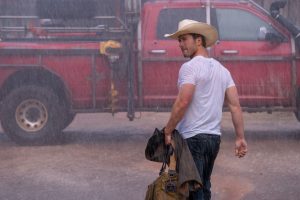Reviews include Deadpool & Wolverine, Doubles, and Mountain Queen: The Summits of Lhakpa Sherpa.
TFCA Friday: Week of May 20
May 20, 2022

Welcome to TFCA Friday, a weekly round-up of film reviews and articles by TFCA members.
In case you missed the news, the TFCA welcomed three new members this week: Marriska Fernandes, Rachel Ho, and Peter Knegt.
We also announced that David Cronenberg has selected emerging filmmaker Kelly Fyffe-Marshall to receive $50,000 in post-production services from Company 3 as part of his win for the Company 3 Clyde Gilmour Award.
In Release this Week!
Box of Rain (dir. Lonnie Frazier; May 24)
“A memorable sweet and charming little doc about the fans of the Grateful Dead that is quite a wonderful experience!” exclaims Gilbert Seah at Afro Toronto.
Chip ‘N Dale: Rescue Rangers (dir. Akiva Schaffer)
“Rescue Rangers is an inventive reboot that takes the series in a bold new direction,” writes Victor Stiff at That Shelf. “It leaves behind the afternoon kids’ show premise for a hardboiled (albeit PG) detective story set in the real world. Think Chinatown meets Who Framed Roger Rabbit. Chip and Dale have new voices, deeper emotional depths, and modern-day struggles. Knowledge of the show helps some of the jokes land, but it’s not required to keep up with the story. I love the way Rescue Rangers blows up our expectations of what a Disney reboot can be.”
“[T]he idea of a Chip ‘N Dale: Rescue Rangers reboot/remake/re-whatever seemed like a recipe for a migraine when it was announced back in 2014, on the heels of CGI Alvin, Simon and Theodore taking the nation’s children by storm. Maybe we deserve the talking, rapping rodents we are served,” argues Barry Hertz at The Globe and Mail. “But between then and now, someone serving deep in Disney’s intellectual-property trench warfare reversed strategy and decided to do something startlingly close to original: this Chip ‘N Dale 2.0 would be a meta take on the very folly of reboots, while also indulging in the cash-cow cultural nostalgia that Disney’s contemporary assembly line is predicated on fulfilling.”
“The film catered more to kids than adults could do with a bit more goofiness and funnier humour like the gophers Mack and Tosh in the Looney Tunes cartoons,” says Gilbert Seah at Afro Toronto.
Downton Abbey: A New Era (dir. Simon Curtis)
The aristos are at it again! In The Globe and Mail, Nathalie Atkinson reviews Downton Abbey: A New Era, and finds the stiff upper Brits at the end of an era: “The film’s sentimental plot may be thinner than a sheet of tissue paper, but it was still moving to this stalwart viewer,” writes Atkinson. “It is subdued and at the core, cast interactions feel palpably elegiac, as though imbued with the real-world zeitgeist of the past couple of years (the exhortation to kindness, especially). Or maybe everyone just knows this movie could be their last hurrah?”
At Zoomer, Atkinson chats with Raquel Cassidy and Kevin Doyle, aka lovestruck servants Baxter and Mosley, about Downton’s long run: “Our characters are a man and woman of our time and are very cautious individuals,” Cassidy explains. “I think that one of the things that Downton — the house — does is it kind of heals the wounded…We see that in Thomas Barrow very clearly but also in the characters who’ve loved and lost — Laura’s character [Lady Edith] has gone through that, Michelle’s character [Lady Mary] as well. And bringing it back to Julian…I think he just knew how to honour these two characters. It’s just very gentle.”
“[S]o many people, so many storylines, the standard high calibre of the wardrobe and set design, Julian Fellowes’ gracious writing, so many moments and emotions crammed into slightly over two hours, a feast for the fans,” dishes Anne Brodie at What She Said. “All our favourites are present, and new and grown-up characters offer chances for exciting chapters here and hopefully in the future.”
“And the movie’s comic scene-stealer is Laura Haddock as Myrna Dalgleish, a Brit-born silent screen temptress whose worst nightmare is to have people hear her working-class accent, one which would make Eliza Doolittle cringe,” notes Jim Slotek at Original Cin. “Director Simon Curtis and writer Julian Fellowes deliver the dual comedies of errors with cheer, sprightly/stately music and the lightest of drama. The scenery, both at Downton and in France, is worthy of Rick Steeves’ Europe. If this is a goodbye (and there are plenty of signals that it is, barring unexpectedly huge box office), it ends on a note of smiles, tears and no hard feelings.”
“It’s all supremely silly stuff, with at least 15% of the screen time filled with shots of one or more characters looking lovingly after others as they leave the room,” observes Chris Knight at the National Post. “Another 15% is beauty shots of the English countryside and the French Riviera, with awkward cuts between the two papered over by John Lunn’s iconic score. And at least 5% is quips from the Dowager Countess, who in true Oscar Wildean fashion keeps them coming until the last possible moment.”
“The film is done all prim and proper as expected from a Downton Abbey film with nothing happening that is surprising nor out of the ordinary, admits Gilbert Seah at Afro Toronto. “Fans will not be disappointed but the 2 hour and 10 minute running time can be trying for others.”
“The only question is the same that British monarchists ask every day, ‘is there life in the old girl yet?’” queries Marc Glassman at Classical FM. “If we’re talking about Maggie Smith, the acerbic and adored dowager of the Grantham estate, the reply is a resounding ‘yes.’ One of the two main plots in the latest epic revolves around Maggie’s Violet—her youth and what exactly happened 50 years earlier in the south of France to inspire the Marquis de Montmirail to give a villa to her in his will.”
Film buffs will relish Downton’s playful throwback to the transitional phase of silent films to talkies. Fellowes’ screenplay smartly avoids exaggerating the tumult of the talkies,” writes Pat Mullen at That Shelf. “A New Era riotously evokes (or steals) the folly of Lina Lamont as Myrna opens her mouth. Leave it to Downton to make things shipshape, though, and A New Era really hits its stride as the Upstairs/Downstairs dynamic meets Hollywood magic.”
Elizabeth: A Portrait in Part(s) (dir. Roger Michell)
At National Post, Chris Knight reveals five things he learned about Liz II after watching the documentary, including news of her skills at the track: “Old footage of her at a race shows the Queen sprinting to the edge of the royal box (I have never seen her move so fast!) to watch the horses cross the finish line. ‘That’s my horse,’ she marvels, and while you’d be forgiven for thinking she owned it, turns out she’d merely bet on it. She won £16 pounds, the money staring back at her with her own likeness.”
Hold Your Fire (dir. Stefan Forbes)
“Hold Your Fire features an array of people directly involved in the 1973 hostage-taking: police officers, psychologists, hostages, negotiators, and two of the hostage-takers,” notes Victor Stiff at POV Magazine. “What’s fascinating here is how the interviewees disagree on the details regarding this notorious event. The lack of consensus on what happened and why reflects problematic issues pervading law enforcement then and now.”
Into the Weeds: Dewayne ‘Lee’ Johnson vs. Monsanto Company
(dir. Jennifer Baichwal 🇨🇦)
“Like many courtroom dramas, Into the Weeds is a compelling and very relatable narrative,” says Marc Glassman at Classical FM. “Baichwal introduces us to Lee Johnson, an African American who was born to make music but needed to make money since he had to provide for his wife, two children, and delightful mother DeLois. In order to make ends meet, Johnson began to work for Monsanto, a company with a problematic past. All went well until a traffic accident involving his vehicle created spillage in Johnson’s delivery truck, forcing him to plunge into the liquid called Ranger Pro in order to stop the flow before it could affect the kids in a grade school.”
“[M]uch of Into the Weeds’ action takes place inside the stuffy and bland confines of a courtroom – not exactly Baichwal’s natural habitat, and a place where, without the aid of sexy actors playing attorneys and the dramatic friction of compressed narrative timelines, documentary drama typically goes to die,” says Barry Hertz at The Globe and Mail. “Yet through deft editing and a keen sense of detail, Baichwal manages to compress the case of Johnson vs. Monsanto Company into a superbly paced, tightly wound thriller. Watch it before you head to the gardening centre this weekend.”
“Director Baichwal has crafted a well-researched documentary that rightfully angers her audience as well as informing and educating,” notes Gilbert Seah at Afro Toronto.
“Baichwal walks us through a lot of information in Into the Weeds, raising urgent and important questions beyond the legal case. RoundUp and Ranger Pro are effective weed killers. But there are scientists, and people like Elder Raymond Owl, the founder of Traditional Ecological Knowledge, who maintain the pesticide doesn’t just kill weeds, but has consequences on insects, birds and other parts of the biosphere,” notes Karen Gordon at Original Cin. “Into the Weeds: Dewayne ‘Lee’ Johnson vs. Monsanto Company is a cautionary environmental story, that raises unsettling questions about what’s in the food we eat, and how our farming practices are affecting the biosphere.”
“Baichwal follows Johnson through the trial against Bayer – a nerve-wracking exercise that details its knowing culpability and its efforts to dodge it,” notes Anne Brodie at What She Said. “Extremely important, essential viewing that affects every one of us.”
“Into the Weeds still captures Baichwal’s sense of looking at a situation through lenses both macro and micro,” writes Pat Mullen at POV Magazine. Mullen chats with Baichwal using a sense of scale to capture the magnitude of all things. “Something that has always irritated me is when people force you to make a choice between social and environmental justice, as though those two things are separate. And as though those two things are competing, when in fact they are absolutely intertwined,” observes Baichwal. “In a story like this one, it’s one person’s experience, but it’s actually thousands and thousands of people’s experiences.
Ip-Man: The Awakening Master (dir. Li Xi-Jie)
“The climactic fight between the two artists (Wing Chun and Bartsitsu) make this action film standout among other films in the genre,” notes Gilbert Seah at Afro Toronto.
The Kids in the Hall: Comedy Punks (dir. Reg Harkema 🇨🇦)
“It’s a miracle to think they put all that behind them to focus on their by now precise art, their decades-long friendship, and love, and make something to carry on the KITH legacy,” remarks Anne Brodie at What She Said. “And they’ve done it – a reboot of the original series and Comedy Punks now available that somehow reassures us that good things are at play in the world.”
At POV Magazine, Rachel Ho speaks with director Reg Harkema and producer Nick McKinney about capturing the wild and rollicking history of Toronto’s The Kids in the Hall: “It’s no accident that we called the film Comedy Punks,” McKinney tells Ho. “The Kids cut through the same way punk did in the late ‘70s and early ‘80s. We were all ABBA’d out, we were Fleetwood Mac’d out. In the same way that The Clash cut through, there was this new possibility. That punky energy is definitely something that’s in the DNA of the Kids.”
Mau (dir. Jono Bergmann and Benji Bergmann)
“The big intervention in Mau—and Bruce admitted to me that he was a bit surprised by it—was to have the designer return to his birthplace on the outskirts of Sudbury, ostensibly to confront the demons of his past—parents who didn’t support him and a childhood filled with people who could never understand him,” writes Marc Glassman at POV Magazine. Glassman also interviews Bruce Mau about his life and work: “Mau: For me, the thing that I fell in love with was ideas and images, and what happens when they come together. That has been a lifelong passion and exploration and there’s no end in sight, as far as I can see. I haven’t exhausted that work.”
“The new documentary Mau by the Austrian brother team of Benji and Jono Bergmann offers some insight into what is termed ‘design thinking,’ the idea that creative design process influences almost every area of human life. Unfortunately, the film is far too busy admiring its subject to offer much insight into the discipline’s real-world applications,” notes Liam Lacey at Original Cin. “Between a chorus of adulatory, talking-head testimonials, and laudatory press clippings, there are scenes shot with Mau at home in Chicago with his wife and collaborator Bisi Williams and in Beijing, Toronto and Guatemala City.”
“It’s not the deepest dive into Mau’s life, but it is an exciting primer on the man and his methods,” admits Chris Knight at the National Post. “Mau has said that one of his desires is to help put the tools of design into the hands of everyone. By that thinking, what you take away from Mau, and what if anything you decide to do with it, is entirely up to you.”
Men (dir. Alex Garland)
“Men is an interesting film for the majority of its runtime. It balances discomfort with moments of immediate horror nicely,” writes Rachel Ho at Exclaim. “In the final third of the film, however, Garland jumps the shark. In a sequence that can only be described as expressive body horror, Men suddenly becomes a bit of a head-scratcher. Rather than go out in quiet, meditative reflection, Garland burns it all down in a bloody, gory fire.”
“Men is definitely a horror film – brace yourself for the film’s final 10 minutes, which get intensely body-horror-freaky – but it’s also a story about trauma and, if that weren’t enough, an examination of the ways that women can feel belittled, unseen or ignored in a world of men,” writes Chris Knight at the National Post. “Buckley is superb in her role, a confident woman made fragile by her recent loss, the details of which are revealed in a steady narrative drip, with one specific left purposefully unknown. And Kinnear, though mostly existing as a series of male caricatures, nevertheless provides some three-dimensionality to his one-man cast.”
“Garland has an impeccable eye for casting. The film has a very small cast, all of whom are excellent,” says Karen Gordon at Original Cin. “The heavy lifting, though is done by two fine, fine actors: Buckley, who may be rattled, but is no ‘female in distress.’ And British actor Rory Kinnear – perhaps best known for his role as Frankenstein’s Monster in Penny Dreadful, and Tanner in the last few Bond movies – who plays almost all the male characters.”
“It doesn’t matter whether any of it makes sense or not – it doesn’t – but there is a distinct lack of effectiveness to Garland’s work here, too,” admits Barry Hertz at The Globe and Mail. “An expert at burying and then unearthing heavy-duty themes through horror and sci-fi (see his script for 28 Days Later and his directorial work on Ex Machina and television’s Devs), Garland rushes straight for the patriarchy’s jugular in Men’s battle of the sexes, leaving a sloppy, bloody mess in his wake.”
Pleasure (dir. Ninja Thyberg)
“Pleasure, about a young woman trying to break into the adult film industry, might just be the least sexy film of the year,” argues Chris Knight at the National Post. “To be clear, that’s a huge compliment. Pornography may have a veneer of respectability and even playfulness in some quarters, but Pleasure isn’t interested in that. It rips the mask off, and it hurts.”
“Thyberg has said her intent was to try to show sex work as potentially positive for women (agency, money) but also show the patriarchal order of the adult entertainment industry,” observes Liam Lacey at Original Cin. “Her approach is, on a certain level, consciously even-handed. It’s shot in a documentary fly-on-the-wall fashion, though layered with a score that toggles between European electronic opera and abrasive American rap.”
“Pleasure is such a welcome, fascinating, difficult and ruthlessly provocative thing to swallow,” chews Barry Hertz at The Globe and Mail. “A sometimes cruel but always committed look at one young woman’s journey from European porn star wannabe to hardcore American XXX icon, the director’s expansion of her own 2013 short film of the same name is an engagingly brutal experience, no matter your familiarity or comfort with modern adult entertainment.”
We’re All Going to the World’s Fair (dir. Jane Schoenbrun)
“What’s most interesting about We’re All Going to the World’s Fair as a horror film is that the threat is not a matter of something coming to get you, but rather what you will become. Akin to a vampire requiring an invitation, a victim’s complicity in “World’s Fair Challenge” seems essential to its formula,” observes José Teodoro at Bloodvine. “At this point in human history, the idea that we are knowingly signing off on our own demise might be the film’s most resonant subtext, though the idea just sort of presents itself for our admiration. All of this is to say that the film is conceptually interesting and dramatically boring.”
“Creepypasta, soggy spaghetti, and self-abuse are all acquired tastes…A sense of screen fatigue hangs atop We’re All Going to the World’s Fair,” yawns Pat Mullen at That Shelf. “Hell isn’t a descent into the dark chasm of Casey’s online lurking. It’s the insufferable banality of escaping doomscrolling and brain-frying video calls by watching people do the very same.”
A Festival of Festival Coverage: Les critiques chez Cannes !
At the Toronto Star, Peter Howell reports from the Cannes Film Festival and reflects upon how the event stands upon his 25th anniversary of covering the Croisette, with a few words from the festival’s Thierry Frémaux: “Back then, the internet was still a novelty and streaming services like Netflix were far off in the future,” writes Howell. “But the focus then and now was on the appreciation of great film, no matter what form it takes or what challenges it faces. ‘Cinema isn’t dead,’ Frémaux said. ‘Language isn’t dead. Everything is renewed. Everything is always renewed.’”
Howell also gives the rundown of one of Cannes’ biggest events: the premiere of Top Gun: Maverick, which featured a length, if tightly controlled, conversation with star Tom Cruise. “When Cruise finally sat down to chat with French journalist Didier Allouch, for a rare interview, he was pushing the angle that he’s just an ordinary guy who got lucky and who works very, very hard,” notes Howell. “He talked about being ‘very humble’ and ‘very privileged’ to do what he does. ‘It’s not about me, it’s about the story,’ he insisted, but nobody was buying it. You don’t go to a Tom Cruise movie because of the story.”
At POV Magazine, Jason Gorber faces the daunting task of assessing Mantas Kvedaravičius’ Mariupolis 2, which screened at the festival mere weeks after the filmmaker was killed during production. “I understand why the festival chose to show Mariupolis 2, but it’s hard to recommend the documentary given how mildly it connects to the original,” admits Gorber. “Instead, I encourage readers to take on the challenge of finding access to the first Mariupolis and see the finished work of a filmmaker who clearly had skill, a keen eye, and a yearning to tell the tale of one city on the break of Armageddon. If he gave his life for his art, we should celebrate his art in its best and most fully realized form.”
TV Talk/Series Scribbles
At What She Said, Anne Brodie finds scary stuff in Elon Musk’s Crash Course, the latest installment of FX’s documentary film series The New York Times Presents: “Included are interviews with former staffers and insiders who detail Musk’s trail of his lies and exaggerations and habit of pulling from thin air things to say that his public found magnetic, bold, and sci-fi-y. Things that have not been backed up,” notes Brodie. A better view of the stars, meanwhile, comes in The Night Sky: “Night Sky’s rich, far-reaching imagination soars into sci-fi and mysticism without sacrificing the characters’ authenticity – Spacek and Simmons are phenomenal.” Laughs can be found in the two-part George Carlin doc (“Don’t miss this. Deja vu all over again”), while Now & Then is a hidden gem (“There’s lots to ponder, the psychological state of the suspects, the illicit sexual escapades of the past and renewed, the chain that binds them together”), and The Time Traveller’s Wife is as good as a stale scone (“romance fluff with a hokey twist isn’t my cup of tea”).



